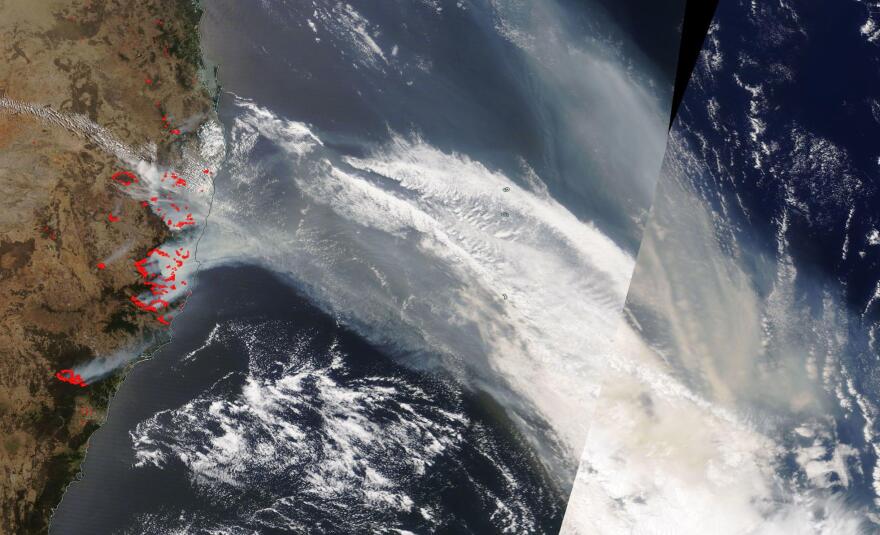Truth matters. Community matters. Your support makes both possible. LAist is one of the few places where news remains independent and free from political and corporate influence. Stand up for truth and for LAist. Make your year-end tax-deductible gift now.
What Massive Wildfires In Australia Have To Do With LA's Back-To-Back-To-Back Years Of Drought

Back in June 2019, one of Australia’s worst bushfire seasons on record got started and didn’t stop for nine whole months, burning more than 40 million acres and killing more than 30 people.
As the landscapes burned, the smoke climbed high into the atmosphere where it was transported around the globe. Some of it arrived several thousand miles away above the Eastern Tropical Pacific, where water vapor in the sky latched onto the surface of the particles, creating a higher density of brighter than usual clouds. Spread out over thousands of square miles, those clouds reflected enough sunlight away from the ocean surface that the waters below them cooled.
Animation of smoke patterns
What the study found
According to a study published today in Science Advances, the cooling of those waters was so great that it could have helped kick off the triple year La Niña we just wrapped up.
“The dice were loaded for dry conditions in Southern California and across the West by the Australian wildfires. They pushed the probabilities towards that being more likely. But certainly I couldn’t put a number as to what percentage more likely," said John Fasullo, climate scientist at the National Center for Atmospheric research and co-author on the paper.
The climate pattern has a range of impacts around the globe. Here in Southern California, roughly 65% of the time, it’s associated with drier than normal conditions, including during two of the last three La Niña years.
“What our model is saying is that once you cool off this key region of the Pacific Ocean it influences La Niña,” said Fasullo.
How La Niña works
The arrival of La Niña is in part signaled by the cooling of waters in eastern parts of the equatorial Pacific. And the model showed that once once ocean temperatures dropped due to wildfire smoke, a feedback loop kicked in.
“You start to cool the surface, the winds become stronger and that leads to more surface cooling. You get a vicious cycle where La Niña Locks in,” Fasullo said.
The particles usually dissipate in a month or so, but because the fires burned for so long, the effects had time to snowball.
“The physical processes that they describe aren’t necessarily new. But the fact that they were able to relate the bushfire in Australia to the Pacific Ocean and therefore the global climate, that connection is quite novel,” said Shang–Ping Xie, climate scientist at the University of California San Diego who was not associated with the paper.

This study’s limits
The authors of the study point out that there are limitations to their modeling. And that there’s a whole host of other reasons that La Niña could’ve established.
“This study really shows, at least with this model, if you jumpstart with aerosol emissions, the equatorial Pacific sea surface temperature can have a long lasting effect over at least two years. That is very clear from the model. But that doesn’t exclude other possibilities, because the models are after all, models,” said Xie.
There are still big questions to answer in follow up studies like, was it cooling specifically in the Eastern Pacific that matters the most or is when the entire Southern hemisphere cools, as also happened following the fires.

The 2019-2020 wildfires weren’t the largest in Australia to date. The 1974-1975 fire season chewed through an estimated 290 million acres, and it just so happens that a La Niña followed not long after.
Studies like these are just one piece of a bigger effort to better model scenarios in the era of climate change.
“There’s the possibility that wildfires could become more important factors in the realm of variabilities such as El Niño and La Niña. So that’s the scary part,” said Xie.
Learn more about big fires
As the world enters a new age of wildfires, I did a deep dive deep into personal stories that illuminate the history of how we got here, why we keep screwing things up, and what we can do to survive and maybe even thrive while the world around us burns.
Listen to The Big Burn here on LAist.com or wherever you get your podcasts.
LAist: Tips and Explainers
- Listen to The Big Burn, our podcast that will get you motivated to get ready
- Wildfires are getting worse. What you need to know
- Understanding climate change may help you feel less helpless
- Every day is now fire season. Let's get you ready for the next wildfire burning near you
- Evacuation terms can be confusing. Here’s what they mean and how to sign up for alerts
- How to keep yourself safe from wildfire smoke
- The air is brown — should I wear a mask? We tested 5 out and have some advice
- This is why fire officials don't want you to stay and defend your home
- What does 'containment' of a fire mean, exactly
- How to avoid getting towed during LA's red flag parking restrictions
- What to do — and not do — when you get home after a wildfire
- If you want to help fire victims, resist the urge to volunteer









